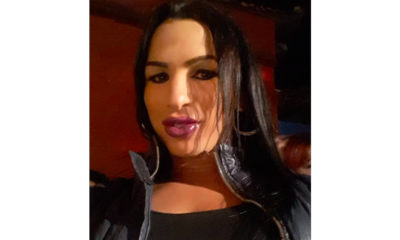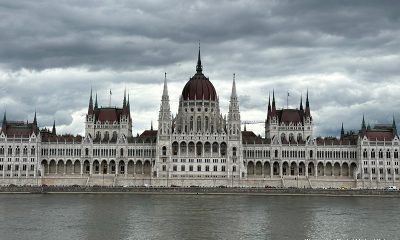Commentary
‘Did this really just happen to me?’
Cuban cell phone was only link to outside world
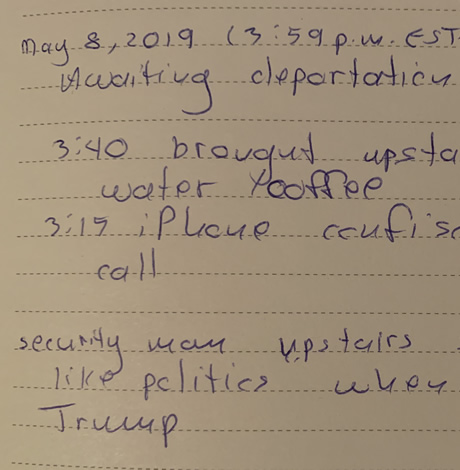
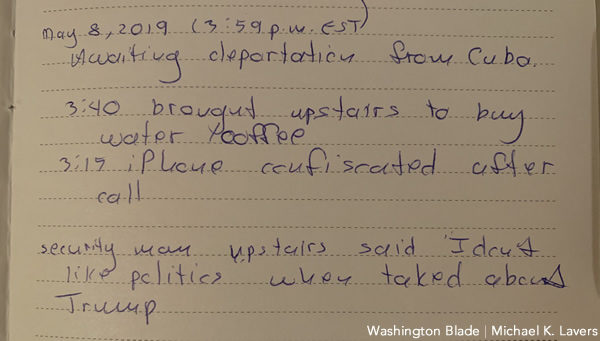
MIAMI BEACH, Fla. — Wednesday was to have been the first day of my seventh trip to Cuba. The country’s government put a quick end to that plan.
My American Airlines flight from Miami landed at Havana’s José Martí International Airport shortly before noon. I was one of the first passengers off the plane.
There were a few dozen people — mostly customs employees — in the large customs hall downstairs when I approached an officer who was sitting in one of the more than a dozen booths. I said “good afternoon” to her in Spanish and handed her my passport and “tourist card” visa that I bought after I purchased my flights last month. She began to enter my information into a computer and after a couple of minutes she told me to stand behind the line at which people wait before they approach the booths.
A woman who I later realized was a customs manager — who subordinates called “la jefa” or “the boss” in Spanish — approached me and asked for my passport and visa. I gave them to her, and then walked over to where Cleve Jones — a San Francisco-based activist who was to have been the grand marshal of a government-approved International Day Against Homophobia, Transphobia and Biphobia march in Havana that was cancelled earlier in the week with little explanation — and two other Americans who were on my flight were waiting for a contact to escort them through customs. The four of us chatted for a few minutes until the customs manager called my name. I walked over to her and a male colleague with whom she was standing asked me three questions: How many times have I been to Cuba? What is my profession? What was the purpose of my trip? I answered each of the three questions and the man then told me I was not allowed to enter the country. I asked him why and the only thing he said was my name was on a list. He directed me to a row of seats near an emergency exit and I sat there with my backpack, carry-on and a plastic bag with things I bought at Miami International Airport before the flight. Someone from Jones’ group asked me what was happening, and I said something to the effect that I was not being allowed into the country. I don’t know if they heard what I said.
I used my iPhone to call my husband in D.C. and text Washington Blade editor Kevin Naff to let them know what was happening. I also used my Cuban cell phone to call a contact in Havana. The person who escorted Jones and the other two Americans through customs arrived a short time later and they left about half an hour after our flight landed. I knew I was going to be on an American Airlines flight to Miami that was scheduled to leave at 7 p.m., but I asked the customs manager to confirm this information and to tell me why the government had refused to allow me to enter the country. She said she didn’t know and apologized to me. She also asked me if I wanted any water or food. I thanked her; but said no because I had a full water bottle, snacks and half a breakfast sandwich from Miami with me. I asked her if I could use the restroom. She said yes and I walked over by myself.
The thought of spending more than six hours in a Cuban airport was dreadful, but I was not overly scared because I had not been formally detained and the customs manager was doing what she could to keep me comfortable. I spent the next couple of hours walking back and forth to the restroom, pacing around the customs hall, using my iPhone’s notes app to write the Blade’s article about what happened and talking to a man from Angola who was not allowed to enter Cuba after he arrived on a flight from Panama. I also called a contact in Havana and told them I was “bored out of my mind.”
A contact in the U.S. called my iPhone at around 3 p.m., and I began to tell them what was happening. The customs manager and the same male colleague who told me I was not allowed to enter Cuba approached me about 15 minutes later and told me I could not use cell phones in the customs hall, even though several of their colleagues were using theirs. The customs manager then told me to turn off my iPhone and give it to her. She then told me she would keep it with my passport and give them back to me before I boarded my flight to Miami.
I felt even more disconnected from the world after they took my iPhone, but I still had my Cuban cell phone. I muted the ringer, placed it into the hat I was wearing and used it to text the contact in Havana with whom I was in contact and to and Maykel González Vivero, publisher of Tremenda Nota, the Blade’s media partner in Cuba. I also took my travel journal out of my backpack and began to write down what was happening. At 3:59 p.m. I wrote “awaiting deportation from Cuba.” I also noted a young male customs employee about 20 minutes earlier walked me upstairs to the departures lounge and allowed me to buy bottles of water and a coffee with Cuban pesos I had from my last trip to the country earlier this year. I wrote in my journal he told me, “I don’t like politics when (we) talked about Trump.” I bought an extra bottle of water for the Angolan man who was sitting next to me downstairs and gave him some of the cookies and dried fruit and nuts I had with me.
The air conditioning was not very strong and it was 90 degrees outside, but I was otherwise comfortable over the next two hours as I waited for my flight back to Miami. At around 6:30 p.m. the customs manager called me over to an elevator. She gave me back my passport and iPhone, handed me my boarding pass and escorted me to the gate. She handed my passport and boarding pass to a gate agent and told a male airport employee to escort me onto the plane. The customs manager said thank you to me as I entered the jet way.
I was the first person to board the plane, which made me feel extremely self-conscious because I was escorted past a group of elderly people in wheelchairs who would have normally boarded well before a 37-year-old man with no health and/or mobility issues. The person who escorted me onto the plane told me before I left customs that American had upgraded me to business class. I sat down in my seat and thought to myself, “Did this really just happen to me?”
I called my husband, Naff and my Havana contact and let them know I was about to leave Cuba. The onboard WiFi allowed me to connect to the Internet, write Facebook and Twitter posts about what happened and text contacts who were able to receive iMessages. I remained on the Internet during the safety demonstration video and take off that a thunderstorm south of the airport made extremely turbulent. The flight landed in Miami shortly after 8 p.m. and I was able to call my mother in New Hampshire and let my relatives know what had happened. A U.S. Customs and Border Protection agent in customs flagged me for a “hard” interview, but it turned out to be nothing more than a simple passport check. I cleared customs in less than 10 minutes and walked downstairs to baggage claim where I retrieved my suitcase that had been damaged. I reserved a rental car, drove to Miami Beach and arrived at a hotel on Collins Avenue I found online shortly after 9:30 p.m.
Coverage of LGBTI issues in Cuba will continue
I first traveled to Cuba in 2015 to cover government-approved IDAHOBiT events. Blade Photo Editor Michael Key and I in 2017 received press visas from the Cuban government that allowed us to cover that year’s IDAHOBiT commemorations in Havana as credentialed journalists. The Cuban government has also allowed me to enter the country with a “tourist card” three times — the most recent time on Feb. 28 — with no questions asked.
I have reported across Cuba over the last four years, from Santiago de Cuba in the east to Pinar del Rio in the west.
I have interviewed pro-government and independent activists and have become friends with many of them. I have interviewed vocal critics of the government in Cuba. I have published photo essays and recorded dozens of videos that document life on the island. I am also all too aware of the Cuban government’s human rights record and its treatment of journalists, regardless of who they may be or the credentials they may have.
Yariel Valdés González, a Blade contributor from Cuba, has asked for asylum in the U.S. because of the persecution he said he faced in his homeland because he is a journalist. The Cuban government blocked access to Tremenda Nota’s website on the island on the eve of the Feb. 24 referendum on a new constitution that once promised to extend marriage rights to same-sex couples. Authorities detained González in October 2016 as he was covering the aftermath of Hurricane Matthew in the city of Baracoa in eastern Cuba and again in September 2017 while reporting on preparations ahead of Hurricane Irma in his hometown of Sagua la Grande in Villa Clara province.
Authorities on Wednesday detained Luz Escobar, a reporter for 14ymedio, a website founded by Yoani Sánchez, a journalist who is a vocal critic of the Cuban government, for several hours after she tried to interview Havana residents who were displaced by a freak tornado that tore through parts of the city on Jan. 27. The contact in Havana with whom I had been speaking from customs told me about Escobar’s arrest after I boarded my flight to Miami. The U.S. Embassy in Havana also tweeted about it.
Notamos que @Luz_Cuba fue liberada. Muy buena noticia pero no deberia haber sido detenida, en primer lugar. #TodosSomosLuz #LibertadDePrensa #Cuba
— Embajada EE.UU. Cuba (@USEmbCuba) May 8, 2019
I tagged Cuban President Miguel Díaz-Canel and other government entities in a Tweet that asks for additional information about why I was prevented from entering the country. I have not received a response, and am not holding my breath for one.
Los funcionarios al Aeropuerto Internacional José Martí no me dieron ninguna explanación sobre la decisión del gobierno cubano de prevenirme de entrar el país. ¿Tienen información que pueden compartir conmigo? @CastroEspinM @DiazCanelB @CubaMINREX @USEmbCuba @EmbaCubaEEUU
— Michael K. Lavers (@mklavers81) May 9, 2019
I know there are increased concerns over an IDAHOBiT march that independent activists have said they plan to hold in Havana on Saturday. I know from Tremenda Nota and other independent Cuban media outlets the country’s economic situation has grown even more dire since I was last in Cuba less than three months ago. I also know President Trump last week threatened to impose a “full and complete embargo” and additional sanctions against Cuba over its continued support of Venezuelan President Nicolás Maduro.
The last two days have been quite surreal, and I continue to process what happened in Havana. I am quite uncomfortable with the fact that I find myself at the center of a story about a country for which I have a deep affection. I also want to avoid the politics and rhetoric over U.S. policy towards Cuba.
I am so incredibly fortunate to have had the opportunity to travel to Cuba over the last four years, to have had the chance to meet many of the island’s LGBTI activists and to have developed lifelong friendships. These feelings — and my commitment to continue my coverage of LGBTI issues in Cuba — have not changed.
Commentary
America’s detransition: The far-right’s coordinated attack on climate policy and trans rights
Progress framed as ‘mistake that must be undone’

What if the far-right’s endgame isn’t just stopping progress, but erasing it altogether? From banning trans healthcare to reversing climate policies, they aren’t just resisting change — they’re trying to force the world back into an imaginary past that never existed.
Across climate policy and trans rights, the right isn’t just opposing change — it’s actively detransitioning America, unraveling progress under the guise of “common sense” and “restoring order.” But this isn’t just about ideology. It’s about power.
From pulling out of the Paris Agreement to banning gender-affirming healthcare, the right has perfected a political strategy that frames progress as a mistake that must be undone. Whether it’s climate action or trans visibility, any step toward justice is framed as dangerous, unnatural, and in need of correction.
And if we look closer, these attacks aren’t just similar — they are deeply connected. By comparing the right’s climate rollbacks and its war on trans rights, we can see a broader strategy at work: One that fuels fear, manufactures doubt, and ultimately serves the interests of those already in control.
The fight isn’t just about policy. It’s about who gets to belong in the future.
The manufactured crisis: Who profits from reversal?
To justify rolling back both trans rights and climate protections, the right leans on manufactured crises — presenting change as a dangerous social experiment gone wrong. And the most effective way to do that? Weaponizing doubt.
Take climate change. Despite overwhelming scientific consensus, climate denialists cherry-pick uncertainties — using rare instances of changing climate models to cast doubt on the entire field.
Similarly, the right has latched onto detransition stories, amplifying a handful of cases where individuals regret transitioning to suggest that all trans people will regret their identities.
By focusing on individual regret rather than systemic realities, these movements create the illusion that climate action and trans healthcare are harmful mistakes rather than necessary progress. The message is clear: We must “correct” these wrongs by detransitioning the country back to a time before this supposed damage occurred.
But who actually benefits from this rollback?
- Fossil fuel companies profit from climate skepticism, ensuring we remain dependent on dirty energy.
- Right-wing politicians fundraise off anti-trans fearmongering while avoiding economic issues that might actually improve people’s lives.
By making people believe they are “fighting back” against elites, the right obscures the actual elites profiting from this manufactured outrage.
The spectacle: Turning trans lives and climate policy into distractions
None of this would work without media spectacle. Right-wing politicians and media outlets know that the most effective way to keep people from questioning power is to keep them emotionally invested in a performance.
Take the far right’s obsession with trans youth. They flood the airwaves with panic over puberty blockers, despite the fact that gender-affirming care is exceedingly rare.
A peer-reviewed study analyzing private insurance claims found that out of more than 5 million adolescents ages 8 to 17, only 926 received puberty blockers and 1,927 received hormone therapy between 2018 and 2022.
Similarly, climate policies are attacked as elitist schemes to control the working class — painting green energy initiatives as an attack on personal freedom, just as gender-affirming care is framed as an attack on children.
By shifting the focus onto symbolic enemies — the “radical trans activist” or the “climate elitist” — the right gives people someone to hate while avoiding the real sources of economic and environmental crisis.
And this isn’t just a cultural strategy. It’s a business model.
Capitalism is in the business of creating problems, then selling solutions.
- Oil companies push carbon capture technology while continuing to pollute — ensuring the crisis is never fully solved, only managed.
- The right promotes “detransition support” while banning trans healthcare, creating a crisis where one didn’t exist.
Both strategies ensure that nothing actually changes, while making people feel like they’re participating in a fight for freedom.
It’s a distraction, and it’s working.
Nature as a battleground: The far-right’s fear of fluidity
At its core, the war on trans people and the war on climate action stem from the same fear: The fear of change.
Queer ecology tells us that nature itself is fluid, adaptive, and in constant transition. Yet, the far-right insists on rigid, binary categories:
- Man/Woman.
- Fossil Fuels/Renewables.
- Traditional/Disruptive.
In both cases, fluidity is framed as unnatural — something that must be controlled through political intervention.
- Fossil fuels are labeled “natural” energy, while renewables are framed as “forced” and “unnatural”—a rhetorical tactic explored in a 2025 study on far-right climate discourse.
- Trans identities are labeled “unnatural choices,” requiring government bans to prevent people from making “mistakes.”
But what’s truly unnatural? The attempt to freeze society in time. The climate has always changed. Gender has always been fluid. The far-right isn’t defending nature — they’re defending control.
The far-right’s detransition obsession mirrors climate rollbacks
Capitalism is not interested in actual progress — it only cares about control.
The obsession with detransition mirrors climate rollbacks in that both are framed as necessary corrections to a mistake.
- The Paris Agreement withdrawal was presented as a return to “energy independence.”
- Trans bans are framed as returning to “biological reality.”
But the goal isn’t returning to a real past. It’s about constructing a version of the past that justifies present oppression.
- Climate denial isn’t about scientific debate — it’s about maintaining corporate power, as Time reported in 2025.
- Anti-trans laws aren’t about protecting kids — they’re about enforcing gender hierarchies, according to a 2025 New York Times editorial.
Neither of these rollbacks is accidental. They are part of a deliberate strategy of control — one that tells us that progress is always temporary and can always be reversed.
Who owns the future?
If we allow the right to detransition America, we risk a world where progress is always reversible, and power remains in the hands of those who benefit from disorder and fear.
The real question isn’t whether these issues are linked — it’s why they were ever separated to begin with. The fights for climate justice and trans rights are one and the same:
- A fight against the illusion of permanence.
- A fight against manufactured crisis and controlled reversal.
- A fight for a future that actually belongs to all of us.
So what do we do?
- We must refuse to accept their manufactured doubt — trans rights and climate action are not mistakes that need fixing.
- We must reject their false nostalgia — there is no past to return to, only a future to create.
- And most importantly, we must recognize that these struggles are connected.
If we fail to see this, we risk allowing reactionary forces to shape the future. But if we understand their playbook, we can disrupt the spectacle and refuse to let them dictate what comes next.
Because this fight isn’t about going back. It’s about moving forward — and making sure no one can take that future away.
Cody Hays is a Ph.D. student at Arizona State University’s Walter Cronkite School, researching media psychology, public understanding of science, and digital misinformation, with a focus on ideological worldviews; they are a Graduate Research Fellow in the MIDaS and Views and Values Labs, executive editor of the Journal of Public Interest Communications, and a nonprofit communications strategist with over a decade of experience in combating disinformation and mobilizing action.
Commentary
History of D.C. Pride: 1995-2007, a time of growth and inclusion
Rainbow History Project plans expansive WorldPride exhibit

In conjunction with WorldPride 2025 the Rainbow History Project is creating an exhibit on the evolution of Pride: “Pickets, Protests, and Parades: The History of Gay Pride in Washington.” In “Freedom on America’s Main Streets,” we discuss how during the 1990s the LGBTQ communities became more prominent across all areas of American life, the circumstances of moving official Pride activities to Pennsylvania Avenue, and the origin of the name “Capital Pride.”
Throughout the 1990s, LGBTQ visibility increased significantly in American society. The LGBTQ community’s presence extended beyond news coverage of AIDS activism, with members participating in various social movements. Gay Black men joined the Million Man March in 1995, carrying banners and signs proclaiming “Black by Birth, Gay by God, Proud by Choice.” Lesbians led abortion-rights rallies, LGBTQ Asians joined Lunar New Year parades, and LGBTQ Latinos marched in Fiesta DC.
Once again, financial difficulties around Pride activities led to the dissolution of the Gay and Lesbian Pride of Washington as an organization and the gay arts and culture non-profit One in Ten took over organizing Pride. One in Ten’s mission was not solely Pride planning, but rather year round activities, including an attempt to make an LGBTQ history museum. Due to the explosion of activities, the crowd sizes, and the growing concerns around feelings of exclusion brought on by the neighborhood’s identity as a primarily gay white male space, in 1995, One in Ten moved the Pride parade and festival out of Dupont Circle to Freedom Plaza on Pennsylvania Avenue.
Although the struggle for bisexual visibility had successfully added the B to the 1993 March on Washington, the push to add Trans and Queer identities to Gay Pride’s name was not yet successful; Pride was reborn as The Freedom Festival. Two years later, in 1997, the Whitman-Walker Clinic became not just a sponsor but also a co-organizer to alleviate some of the organizational and financial challenges. It was during this time that the event was officially renamed Capital Pride.
The name change sparked debate within the community. Frank Kameny, who had organized the 1965 pickets, harshly criticized the new name, arguing that it “certainly provides not an inkling of what we really mean: Pride that we are Gay.” He lamented that the name change “represents Gay shame.” However, others celebrated the inclusivity of the new name. L. A. Nash, a self-identified lesbian, wrote, “Gay is good—Gay, Lesbian, Bisexual and Transgender is far better.” Elke Martin further supported the change, stating, “A name is your identity, it gives you legitimacy and a seat at the table.” Capital Pride’s official name was now “Capital Pride Festival: A Celebration of Lesbian, Gay, Bisexual, Transgendered Community and Friends.”
In April 2000, the Millennium March on Washington highlighted divisions within the gay civil rights movement. Unlike previous grassroots marches organized by local activists, this event was orchestrated by national organizations like the Human Rights Campaign. However, its Millennium Pride Festival was by far the largest event with major headliners performing, including Garth Brooks and Pet Shop Boys. Critics argued that these events represented a corporatization of activism that sidelined political demands and local groups struggling for recognition.
In 2001, Capital Pride events were attracting 100,000 attendees. The festival was held on Pennsylvania Avenue with the U.S. Capitol in the background of the main stage. This location, often referred to as “America’s Main Street,” symbolized a significant visibility boost for the LGBTQ community. However, the Washington Post failed to cover the event beyond a simple listing in its events calendar. The outrage that ensued led Capital Pride director Robert York to state: “This is the biggest and best Pride we’ve had, and it is important to see it covered other than in the gay press.”
It wasn’t until 2007, however, that SaVanna Wanzer, a trans woman of color and Capital Pride board member, successfully established Capital Trans Pride. “The transgender community needs its own event,” Wanzer stated, “rather than just using us as entertainment. That’s all we’ve been allowed to do.” Trans Pride’s creation was a significant step toward greater inclusivity within the LGBTQ community.
Our WorldPride 2025 exhibit, “Pickets, Protests, and Parades: The History of Gay Pride in Washington,” will be installed on Freedom Plaza on May 17 to coincide with DC Trans Pride. We need your help to make it happen.
Commentary
On this Transgender Day of Visibility, we can’t allow this administration to erase us
All people deserve to have our experiences included in the story of this country

By KELLAN BAKER | Since 2009, the world has observed Transgender Day of Visibility (TDOV) each March 31. The importance of ‘visibility’ feels especially significant this year, not only as a trans person but for me as a researcher whose career has been centered on equity and inclusion for transgender people. My work over the past 16 years, which has focused on advancing fairness, access, and transparency in health care for gender diverse populations, could not have prepared me for the speed and cruelty at which the Trump administration has worked to literally erase transgender people from public life.
From banning transgender people from serving openly in the military, blocking access to best practice medical care, and making it all but impossible for us to obtain accurate identification documents that match our gender, the impact of these attacks will be felt for years to come. As a scientist dedicated to fostering the health and wellbeing of diverse communities, I am particularly devastated by the intentional destruction of the federal research infrastructure and statistical systems that are intended to ensure the accurate and comprehensive collection of data on the full diversity of the U.S. population.
The importance of data cannot be understated. This makes the efforts by the federal government to remove survey questions, erase variables from key data sets, and stifle research even more alarming. By simultaneously removing access to existing datasets, removing gender (and other key measures, such as sexual orientation, race, and disability) from key surveys, terminating federal funding for research projects that include trans people, and censoring research projects at federal data centers, this administration’s goal is to erase the lived experiences of trans people – with the idea that if we don’t exist in data and in research, the federal government can claim that we don’t exist at all.
Just in the past two months, we’ve seen a rapid decimation of the inclusion of transgender people in federal research and their visibility in the federal statistical system.
Data sets that included gender measures have disappeared from federal websites. Critical data sets used by federal and state policymakers, public health staff, and researchers, such as the Youth Risk Behavior Surveillance System (YRBSS), were removed from the CDC website in response to a Trump executive order that made it the policy of the administration to recognize only two sexes, male and female. Although some datasets have been put back up, gender variables have been removed.
Surveys that had asked about gender identity no longer do. Claiming that the removal of gender identity measures from key national surveys such as the American Housing Survey, Household Pulse Survey, and National Health Interview Survey were “non-substantial,” the Trump administration has essentially skipped the extensive notice and public comment process that is required to make these types of changes—the same process that were used to add gender identity (and sexual orientation) measures.
In addition, attempts to exclude trans people and other communities facing disparities from surveys will result in a lack of large enough sample sizes to conduct quality data analysis, while reducing any chance of analyzing racial and ethnic differences among trans people.
Hundreds of grants supporting inclusive research have been terminated. The unprecedented move of the National Institutes of Health (NIH) to terminate research grants that include transgender people is just one example of this administration’s rush to eliminate funding from active scientific projects. In many cases, similar agencies are also now required to remove gender identity measures from federally supported surveys. Prominent trans health researchers have watched as their research portfolios are halted, work stopped, staff laid off, and participants left without care.
At the Institute for Health Research & Policy at Whitman-Walker, for example, we have already had seven studies terminated, with a financial impact that exceeds $3 million. One of these cancelled grants was a multi-year, longitudinal study in partnership with the George Washington University to explore the impact of structural racism and anti-LGBTQ bias on HIV risk among young queer and trans people of color nationwide. The notices of termination for this and other awards clearly spell out the administration’s disdain for groundbreaking research that seeks to understand and address health disparities related to LGBTQ populations, particularly trans people.
Censoring research. As seen with recent changes implemented by the CDC, the censorship of gender-related terms on federal websites and scientific publications is intended to further the erasure of evidence detailing the disparities faced by LGBTQ people.
On a day dedicated to honoring the lives and contributions of trans people, the impact that these egregious actions will ultimately have on the health and wellbeing of trans and nonbinary people is chilling. Without access to this knowledge, researchers will not be able to examine the repercussions of the harmful policies put forth by this administration and many states across the country, including bans and restrictions that negatively impact trans people’s physical and mental health, economic security, and educational outcomes.
Although there has been an effort by non-government entities to collect and store previously collected data prior to the Trump administration’s purges, state surveys, private research firms, and academics cannot fill the void left by the federal government’s decision to halt data inclusion. Ensuring that public entities and researchers can continue to use these datasets is only one piece of the puzzle being taken on by groups such as the Data Rescue Project and repositories like Data Lumos. Work also continues thanks to the efforts of the U.S. Trans Survey, the California Health Interview Survey (CHIS), and the important research and analysis of both Gallup and The Pew Research Center. Yet, gaps still exist due to threats of federal funding cuts to organizations committed to safeguarding inclusive data assets in the wake of the administration’s continued assault on trans rights.
This administration suggests that removing one of the only tools available for identifying an entire population of people is a “non-substantial” action. This not only questions the intelligence of the American people but is a direct insult to trans folks everywhere. All people deserve to be counted and to have our experiences included in the story of this country. Transgender people have always been a part of this country, and even if our nation’s surveys choose to exclude us, we continue to exist—authentically, unapologetically, and forever visible.
Kellan Baker, Ph.D., M.P.H, M.A., is executive director of the Institute for Health Research & Policy at Whitman-Walker.
-
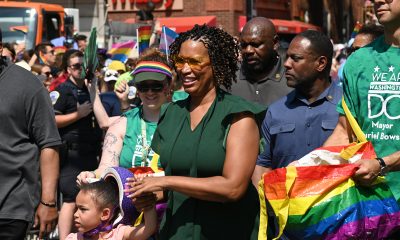
 District of Columbia4 days ago
District of Columbia4 days agoFinal push to raise funds, fill D.C. hotels as WorldPride nears
-

 District of Columbia4 days ago
District of Columbia4 days agoReenactment of 1965 gay rights protest at White House set for April 17
-
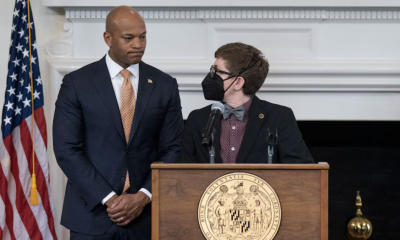
 Maryland4 days ago
Maryland4 days agoFreeState Justice: Transgender activist ‘hijacked’ Moore’s Transgender Day of Visibility event
-

 El Salvador2 days ago
El Salvador2 days agoGay Venezuelan makeup artist remains in El Salvador mega prison



